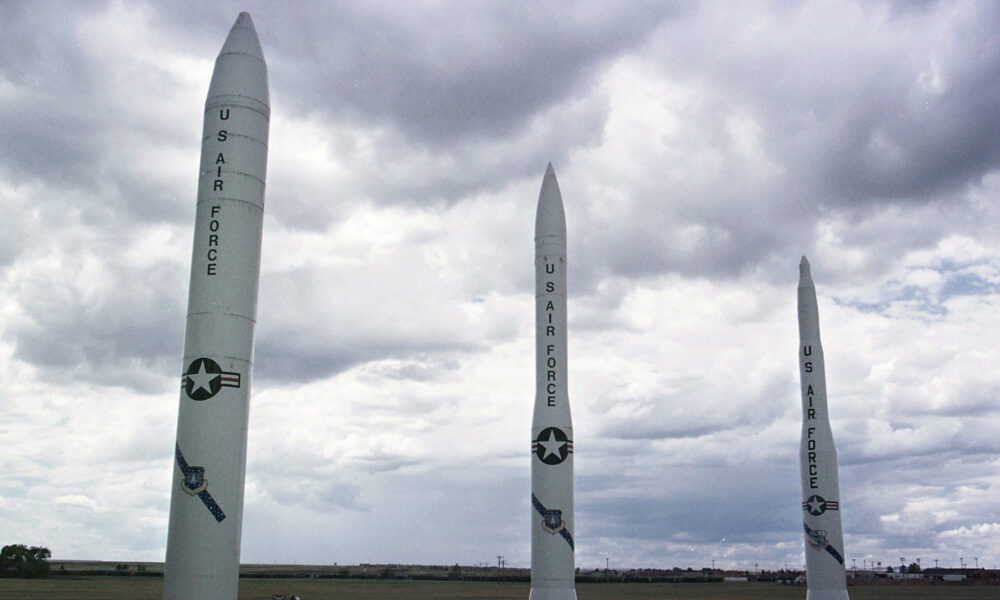Nuclear weapons production in the United States is kicking into high gear. Rather than maintaining and refurbishing its arsenal of roughly 3,700 nuclear weapons, work is underway to introduce the United States’ first brand-new nuclear warheads since the end of the Cold War, with more to follow in the coming decades. This marks a transition and potential departure from the very successful post-Cold War program of “stockpile stewardship” that has been used to ensure the readiness of the US nuclear arsenal for more than 30 years now.
As the United States revives production capabilities that haven’t been exercised in decades, it seems likely that the scope and cost of its ambitions will prove unwieldy. Every part of the US nuclear triad is currently slated for replacement, including the bombers, missiles, and submarines that would carry the new generation of nuclear warheads. Add to that the Trump administration’s renewed ambitions for space-based missile defense and it is clear that some elements of the US nuclear fervor will prove unachievable.
Critics, including the Union of Concerned Scientists, have questioned the fundamental need for this sweeping modernization, particularly given that its price tag is expected to top $2 trillion over 30 years—roughly equivalent to two Manhattan Projects every year (in adjusted dollars, without counting missile defense). Meanwhile, schedules for warheads, delivery systems, and major infrastructure projects either don’t exist, are wildly unrealistic, or are decoupled from each other. When reality catches up to ambition, realistic priorities will have to be identified.
The US Department of Energy (DOE), which oversees US nuclear weapons, appears to be taking note and is now ordering a review of the National Nuclear Security Administration’s (NNSA’s) plans to make new plutonium “pits”—the fissile cores of thermonuclear weapons. They are right to do so—plutonium pit production is one of the most complex parts of US modernization efforts and one where available alternatives are not only possible, but perhaps inevitable, lest the program repeat the costly failures evidenced in other large NNSA capital projects.
Do we need new manufacturing?
There are two logical reasons for new manufacturing of any component: either you don’t have enough, or the parts you do have are deemed unsuitable or beyond their useful service life. In the case of plutonium pits, neither is true.
The United States has more than 15,000 plutonium pits in storage from disassembled weapons. Pit design has evolved over time, but many of these pits are believed to be eligible for reuse. More than 5,000 are available from a single design and were already proven suitable for reuse with full-scale tests.
The service life of plutonium is a more complicated question, but an abundance of scientific evidence suggests that plutonium does not suffer catastrophic degradation on timescales relevant to the existing stockpile (unless it is improperly stored, which could expose it to corrosion). In fact, several studies point to an age-related stabilization in plutonium on timescales beyond a few decades.
The NNSA contends that reuse of the fissile components in the stockpile is reaching its limit, which implies that the era of stockpile stewardship (in which life-limited components are updated without changing the fundamental weapon design) may also be coming to a close. Obligated to plan for the nuclear stockpile of the next century, NNSA officials worry about as-yet-unknown age-related issues but, more glaringly, they worry that they have completely and utterly allowed the United States’ capability to manufacture plutonium pits at all to languish.
A clumsy approach
In response to this dilemma, the NNSA is building two pit production facilities: one at Los Alamos, New Mexico (which has been authorized to make pits since the 1990s, but did not maintain production readiness), and one at Savannah River, South Carolina. The latter has an estimated completion cost of $18 billion to $25 billion, which would make it one of the most expensive projects in US history. Meanwhile, round-the-clock work is being carried out at Los Alamos to meet an artificial production mandate as the first certified pits trickle off the production line.
Although having redundant facilities is cited as a benefit by the NNSA, which is required by Congress to establish a “resilient and responsive” nuclear infrastructure, pit production will be unique in having multiple sites capable of delivering the same component. No other part of the US nuclear enterprise has such redundancy, leaving remaining bottlenecks that redundant pit production facilities will not alleviate. In this case, duplication of effort adds cost, complexity, and risk with minimal added benefit. Given delays that may push the Savannah River project at least a decade away, Los Alamos may be called upon to build the mandated 80 pits per year on its own, despite having more constrained infrastructure and working out of an aging facility that was deemed insufficient for the task as recently as 2017.
Just as the decision to split production between two sites is likely dominated by politics rather than expediency, so too is the pit production quota that the NNSA is struggling to achieve. Congress set out annual goals for production (which have come and gone) and an overarching goal of 80 pits per year by 2030. The NNSA has publicly acknowledged that it cannot and will not meet that requirement but the good news is that it doesn’t need to.
Alternative paths forward
There is no urgency to launch pit production. Plutonium in the existing stockpile is not at risk of failure and new pits would only be to supply future warheads. The United States can continue to maintain its existing weapons without new pit production for decades into the future (at least). As the DOE and Congress scrutinize the current approach, they have several options available:
- Forego new warhead programs and continue the demonstrated success of life extension and refurbishment of existing designs. Nearly every warhead in the existing arsenal has been successfully refurbished; many of them quite recently. Even applying conservative estimates of pit lifetimes, new pits would not be required for the existing stockpile for decades. Continuing with the proven success of science-based stockpile stewardship, rather than replacing existing weapons with ever more sophisticated ones is arguably the most conducive path for nonproliferation, advances in arms control agreements, and reduction in global nuclear tension that threatens a multi-polar arms race.
- Exhaust pit reuse options to reduce pressure on production. If new designs are to go forward, they can do so with reused pits. The NNSA designated Los Alamos as being responsible for pits for a new land-based intercontinental ballistic missile (ICBM) warhead called the W87-1 and Savannah River as the production site for a new submarine-based warhead called the W93. Shortly thereafter, they admitted that up to half of the W93s will rely on reused pits, and it is now known that the NNSA previously explored the viability of reuse for the W87-1 and may now resort to reuse for some of these as well.
This calls into question the urgency and necessity of new pit production at all while also confirming the viability of pit reuse to satisfy immediate demand. Production requirements can be significantly relaxed by exhausting options for pit reuse before (or even while) pursuing longer-term production capability at an appropriate scale. - Commit to a single warhead for ICBMs. Pit production for the land-based leg of the nuclear triad is only required if the United States wishes to upload multiple warheads on a single missile, which, at the present time, would likely be construed as a dangerous international provocation while simultaneously rendering each US missile silo a more valuable target. Since 2014, the US has maintained a single warhead on each ICBM in response to successful arms control negotiations.
Roughly the first decade of pit production at Los Alamos could be alleviated if the United States committed to maintaining a single W87-0 warhead on its ICBMs. The existing W87-0 is one of the newest designs in the stockpile and includes modern safety and security features, and there are enough to arm every ICBM even if the United States retires its other ICBM warhead, the W78. Although there is a long-held dogma that each leg of the triad must have redundant warhead designs, there is scant justification in this case given the capabilities of US nuclear-capable submarines. - Eliminate land-based ICBMs. The W87-1 warheads are being designed for a brand-new ICBM called Sentinel, which is slated to replace the existing Minuteman III missiles in 400 silos across the northern plains. The problems with Sentinel have been extensively documented elsewhere, including tremendous cost overruns, the need for new silos, and the strategic instability inherent in the land-based leg of the triad. Sentinel’s troubles have recently compelled the Air Force to admit that what it had previously deemed impossible—life extension of existing Minuteman III missiles—will now be required, at least through 2050. In addition to the exploding cost to replace ICBMs (already north of $140 billion), the anticipated delays and uncertainty significantly reduce the salience of the W87-1 with its new pits, which are designed for the new missile.
Benefits of restraint
International observers will no doubt view the current US modernization as confirmation that the United States intends to double down on its nuclear dependence and is even poising itself to expand its arsenal going forward. Such perceptions are unlikely to prove constructive for international dialogue, and concerns have been amplified by the recent US bombings of Iranian nuclear facilities, US withdrawal from treaties, and increasingly isolationist foreign policy.
While the NNSA often touts its capital investments as “building the capacity for the future stockpile,” the lessons of the Cold War have shown that in an arms race, there is no such thing as adequate capacity. This is particularly true in today’s world with rapidly shifting alliances and nine nuclear-armed states.
An administration that prides itself on cutting costs and trimming fat from oversized government programs should take note that scaling back US nuclear ambitions would likely pay dividends for global diplomacy. On the other hand, clumsy execution and failure to complete overly ambitious plans may actually undermine perceptions of US deterrence, which is why even proponents of a modernized arsenal should embrace an achievable path forward. If the desired goal is truly a “responsive and resilient” nuclear infrastructure, then oversized ambition, lack of schedules, and exploding budgets are not the way to achieve it.
As a key part of US nuclear modernization, the DOE and this administration have a chance to issue a course correction for plutonium pit production. The question is whether they will take it.
For more on the topic of plutonium pit production, please see our recent comprehensive report.

